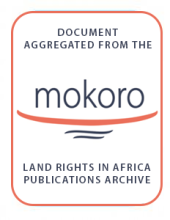Land Library
Bienvenue dans la bibliothèque du Land Portal. Explorez notre vaste collection de ressources en libre accès (plus de 74 000), comprenant des rapports, des articles scientifiques, des articles de recherche, des publications évaluées par des pairs, des documents juridiques, des vidéos et bien plus encore.
/ library resources
Showing items 1 through 9 of 25.This book, prepared by the Philippine Environmental Governance Project, serves as a reference guide for field personnel in guiding communities, investors, local government units, private persons and other organisations desiring to apply for tenure instruments on forest lands.The book covers all e
Research on collective action confronts two major obstacles. First, inconsistency in the conceptualization and operationalization of collective action, the key factors expected to affect collective action, and the outcomes of collective action hampers the accumulation of knowledge.
Criteria and indicators (C&I) are tools to define, communicate and evaluate the sustainability of forest management.
Fires are considered a potential threat to sustainable development for their direct impacts on ecosystems, their contribution to carbon emissions, and impacts on biodiversity. In 1997/98, Indonesia had the most severe fires worldwide, and smoke haze pollution recurs yearly.
The purpose of this manual is to help trainers in future scenario better facilitate training workshops for field officers such as forestry managers, extension officers and researchers who are keen to facilitate future scenarios in their forest management projects.
Argues that the price of commercial farmland in Namibia is high in relation to the profits that can be made from commercial livestock farming.
The diversity of C&I sets is often a cause for uncertainty and confusion, and probably one of the reasons for the still unsatisfactory acceptance of C&I as a support for implementation of sustainable forest management so far.
Big-leaf mahogany was studied on nine mixed-species stands that became established naturally between 2 and 75 years ago after catastrophic disturbances (hurricane blowdown, fire, or bulldozer clearing).




